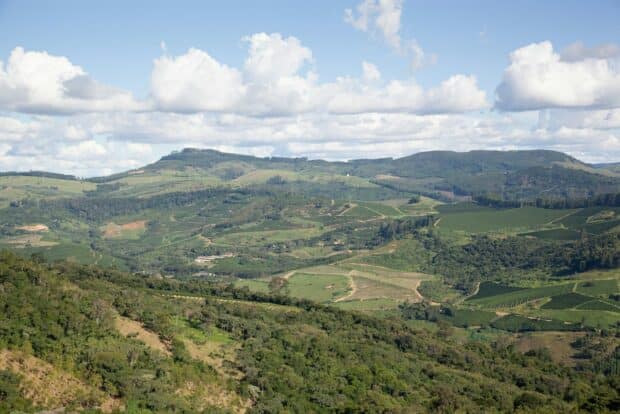[[{“value”:”
Better weather and higher demand for Brazilian coffees — the latter caused by weather-related production shortages in Vietnam and other key countries — is projected to contribute to increased production and exports in the 2024/25 market year.
Combined with a prolonged period of (relatively) high international prices, the projected total production increase of 5.4% is expected to generate higher-than-normal revenues for the Brazilian coffee industry, reaching an estimated US$10.7 billion.
These and other issues are outlined in the new USDA Foreign Agriculture Service annual report on the Brazil coffee sector.
[Note: This is part of a series of stories that will explore USDA FAS annual coffee reports. The information agency typically delivers more than a dozen country-level reports on the coffee sector, each coming from different authors and field offices, with predictions for the 2024/25 market year.]
Production
The FAS office now estimates Brazil’s coffee production for the 2024/25 marketing year will reach 69.9 million 60-kilogram bags, a 5.4% increase from the previous year.
Arabica coffee production is expected to rise by 7.3% to 48.2 million bags, while robusta production is forecasted at 21.7 million bags, a 1.4% increase.
Brazilian agricultural agencies CONAB and IBGE have projected lower figures for the 2024 harvest than the FAS report, with total harvest estimates at 58.8 million and 60.2 million bags, respectively.
Infrastructure Issues
Brazilian coffee exporters face significant logistical challenges, with 81% of shipments delayed at main ports in March 2024, including 80% at the key Port of Santos, causing delays of up to 39 days, according to a report from the Brazilian exporters association CECAFE.
Limited gate access at port terminals exacerbated planning issues, according to the CECAFE report, resulting in increased fees to exporters and a higher incidence of missed deadlines with international buyers.
The FAS noted that the industry struggles with labor shortages for manual harvesting, forcing farmers to start harvesting earlier than optimal or prioritize parts of their crop.
Exports and Revenue
Brazil, the world’s largest producer of arabica coffee and second-largest producer of robusta, has witnessed increased demand due to poor harvests in Vietnam and disruptions in the Red Sea, driving up global robusta, according to the analysis.
The Brazilian Ministry of Agriculture projects the 2024 coffee harvest to generate a gross revenue of approximately US$10.7 billion, a 17% increase from 2023, with arabica accounting for 72% and robusta 28%.
Arabica coffee revenue is expected to rise by 9.4%, while robusta revenue is forecast to grow by 29%, given favorable weather conditions in Brazil.
Export Trends
In 2023, coffee-producing countries imported 2.35 million bags of coffee from Brazil, a 16% increase from the previous year, with Colombia being the largest buyer at 1.09 million bags, according to the analysis.
Vietnam and Indonesia significantly boosted their Brazilian coffee imports in early 2024 due to climatic and logistical challenges, with Vietnam increasing by 212% and Indonesia by 119% compared to the same period in 2023.
Brazil’s specialty coffee exports surged by 45% in the first two months of 2024, totaling 1.57 million bags and generating $356.9 million, with the United States being the top destination, according to the report.
Consumption
Brazil’s domestic coffee consumption for 2024/25 is forecast to increase to 22.67 million bags. Analysts consulted by the FAS post estimated that domestic consumption accounted for nearly 40% of total Brazilian coffee production.
The Brazilian Coffee Industry Association (ABIC) reported that domestic consumption from November 2022 to October 2023 was 21.67 million bags, with roasted and ground coffee making up 95% of this total.
Soluble coffee consumption in Brazil has been rising steadily since 2016, reaching a record 1.05 million bags in 2023, reflecting a 5.2% increase over the previous year, according to the analysis.
Comments? Questions? News to share? Contact DCN’s editors here.
Related Posts
“}]]


